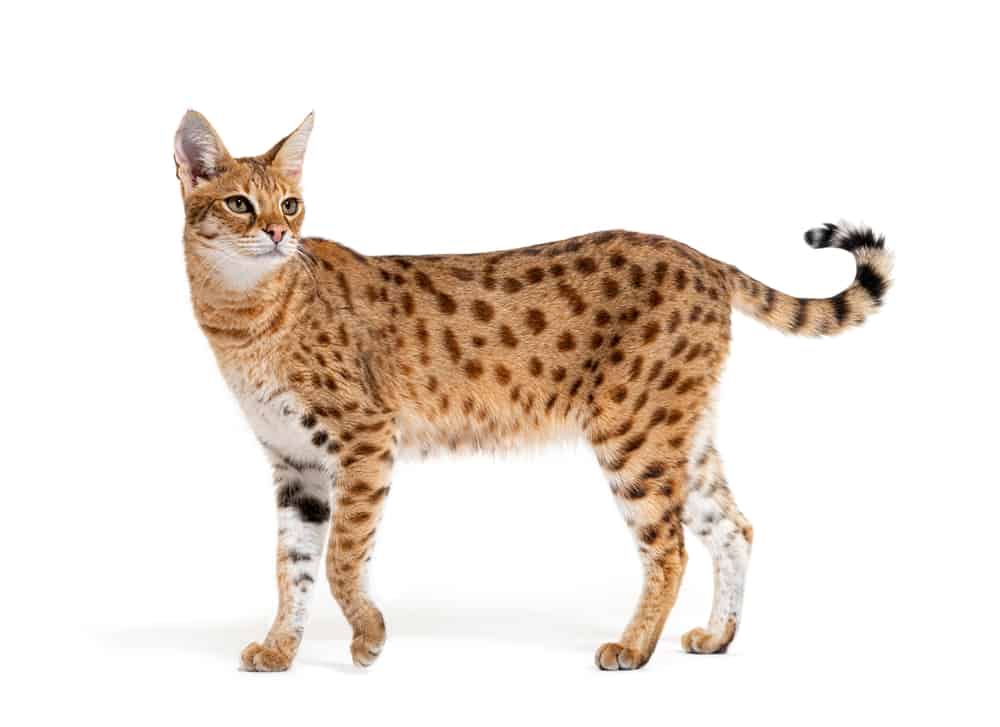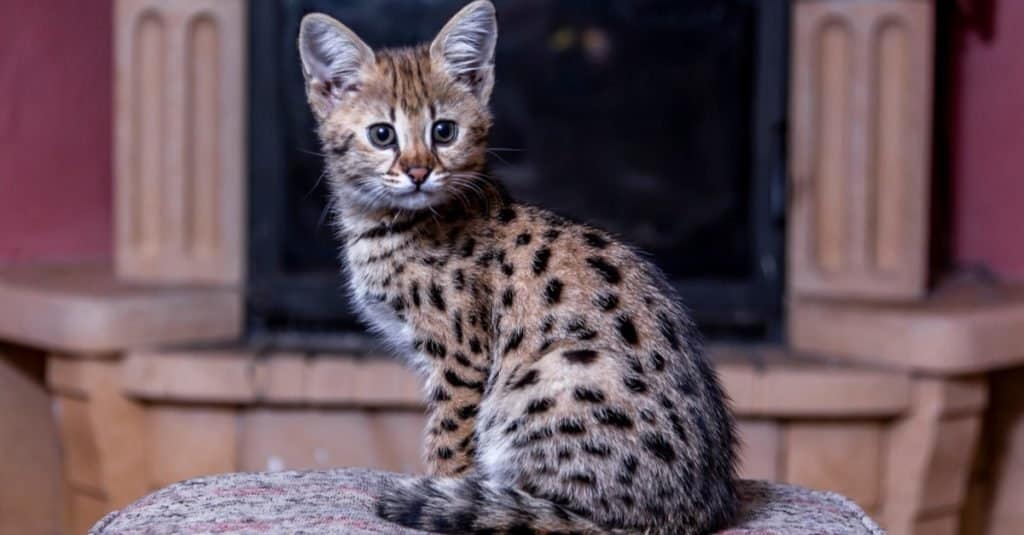The Savannah cat is an incredible cat breed created in the late 1980s. Made by crossing a Siamese cat to an African serval, the first kitten was born on April 7th, 1986. She was named Savannah and she became the mother of the breed. Many people fancy Savannah cats due to their immense size compared to other domestic cats and their unique personalities.

Unique and beautiful, Savannah cats live in homes as pets worldwide.
©Eric Isselee/Shutterstock.com
Much taller than your typical house cat, Savannah cats weigh more than others, too. Reaching anywhere from 10-40 pounds, depending on their generation, they are quite large animals.
Like other hybrid cats, such as the Bengal cat, Savannahs are designated by their generation number. The first cross is F1. An F1 bred to another cat makes F2 kittens and so forth. Only F5 and higher males are fertile (able to produce kittens), so the lower-generation males are most often sold as pets. Some places have outlawed Savannahs altogether, while others allow only F5 or higher. These laws vary from country to country and even state to state.
Savannah cats usually have large, rounded ears, long legs, and beautiful spotted coats. They sometimes have marbled patterns, as well. Their striking appearance is a major factor in their popularity. However, many people brag about their fun-loving personalities. They tend to enjoy a multitude of activities from playing with toys, going on walks, hiking, swimming, and more!
The average Savannah cat weighs between 12 and 25 pounds. Savannah cats, like many cats, develop in stages. Let’s go over the growth milestones for the breed!
Newborns
Newborn Savannah kittens enter the world blind and deaf after 65-75 days in the womb. They rely solely on their mother for food, warmth, and protection at this time. Their eyes begin to open between 10-14 days, though their ears open a little sooner. These tiny kittens know their mother’s scent, and their only goal at this stage is to eat, sleep, and grow.

Savannah kittens take longer to grow than other domestic cats due to their wild cat heritage.
©Kolomenskaya Kseniya/Shutterstock.com
Kitten
Once Savannah kittens reach about 3 weeks old, they begin to crawl and walk. They spend time learning to wrestle with their siblings, building muscle and a sense of balance. By four weeks, their teeth erupt and they begin to try mom’s food. At six weeks, Savannah kittens learn to use the litter box and continue watching their mother for clues about how to be a cat.
Because they are hybrid cats, they need to spend a little more time with their mother than eight weeks (the typical age for pets to leave their mother). In their best interest, the babies should stay with their mothers until they are at least 12 weeks old. Lower-generation kittens may require a full 16 weeks of development before they are ready for adoption. Between 10-16 weeks, Savannah kittens are solidifying their good litter habits, ability to eat solid foods, and how to interact with other cats.
Newborn to Kitten Milestones for Savannah Cats
- Birth: blind and deaf, totally relying on mom
- 1 week: doubled weight since birth, able to move around by pulling with their front legs, able to hold head up on their own
- 2 weeks: eyes and ears open, beginning trying to stand, cannot see very far
- 3 weeks: teeth begin to erupt, sight and hearing improving, learning to stand and walk
- 4 weeks: walking, running, and beginning to play
- 5 weeks: beginning to learn social skills with humans and other cats
- 6 weeks: learning to use the litter box, play fighting with siblings, learning to groom themselves
- 7 weeks: eating solid foods, relying less on mom, curious about their surroundings
- 8 weeks: coordination nearly fully developed, full of energy, independent, first vaccines
- 9-16 weeks: continuing to build confidence, learning about their environment, meeting their new family, eating and using the litter box consistently without help, vaccines every 3-4 weeks until 18-20 weeks old
Adolescence
As Savannah kittens reach 12-16 weeks old, they enter adolescence. This period is marked by growth spurts and blasts of energy. Usually, this is the time when they go to their new families, who enjoy watching their silly antics and curiosity. The Savannah cat is extremely athletic due to its long and lean build. They can jump very high and love to chase toys. Some of them go on walks with their owners, while others learn to play fetch. Adolescence is their most active time and they will need lots of playtime and exercise. At a year old, they are considered adults.

Savannah cats sport large, rounded ears and spotted coats. They sometimes have a marbled coat.
©Nynke van Holten/Shutterstock.com
Adulthood
The Savannah cat continues to grow well past their first birthday. At approximately three years old, the Savannah cat reaches its full adult size. The lifespan of the Savannah cat ranges from 12-15 years, with some living into their 20s. These cats often behave like kittens well into their upper years.
Health Problems Savannah Cats Face
Like many purebreds, Savannah cats face several health problems potential adopters should learn about. Choosing a responsible breeder can help eliminate some of these concerns.
HCM
Hypertrophic cardiomyopathy (HCM) is a disease affecting the heart. It causes the inner walls of the heart to thicken over time and prevents blood from flowing efficiently. This can cause the heart to grow larger overall to compensate. This disease has no cure and is thought to be genetically transmitted (from parent to kitten). The only way to test for this condition at the present time is by echocardiogram through a board-certified veterinary cardiologist. The test is technically only good for the moment it is performed because changes in the heart can happen rapidly. Breeders test their cats yearly to monitor for changes. Many Savannah cat lovers hope a more definitive test will be developed.
PK Def
Pyruvate kinase deficiency (PK Def) is a disease that impacts the creation of red blood cells. Savannah cats affected by this disease suffer from anemia (or low red blood cell counts). Anemia leads to tiredness, muscle loss, and eventually death if not treated. The only way to help this problem is through blood or bone marrow transfusions. These methods are costly and rarely go well for the cat. The good news is this disease has a simple mouth swab test that allows breeders to determine if their cats are carriers. A carrier should never be bred to another carrier.
PRA
Progressive retinal atrophy (PRA) is a condition that causes the retina to deteriorate over time. There is a test available for this disease, but the test is not fail-safe as it cannot test for all forms of PRA. Unfortunately, it is unlikely to know a cat has PRA until they have become nearly completely blind. That’s because cats are incredibly good at adapting. In any case, there is no cure or treatment for this condition.
The Savannah cat with PRA will begin to experience decreased vision between 2-6 years old. The condition will worsen with age until the cat is completely blind. While not life-threatening, blindness sometimes significantly impacts a cat’s quality of life. Thankfully, many cats adapt well to blindness and the disease is painless.

Choosing a responsible breed reduces the likelihood of problematic health conditions for Savannah cats.
©Kolomenskaya Kseniya/Shutterstock.com
Interesting Facts About Savannah Cats
Before we bring this article to an end, let’s take a look at some interesting Savannah cat facts!
- Savannah cats come in four colors: brown, black, silver, and smoke. This is according to The International Cat Association (TICA) standard for these cats. They can also come in blue, snow (white with points), chocolate, cinnamon, fawn, lilac, and red.
- They’ve won Guinness World Records: the record for the tallest cat alive went to an F2 brown spotted Savannah cat named Fenrir in 2022. Two other Savannah cats have held this record.
- They like water: unlike most cats, Savannah cats often enjoy swimming and playing in the water.
- Savannahs love their humans: these cats famously bond closely with their families. They are frequently described as dog-like because they will follow family members around the house.
The photo featured at the top of this post is © kuban_girl/Shutterstock.com
Thank you for reading! Have some feedback for us? Contact the AZ Animals editorial team.







